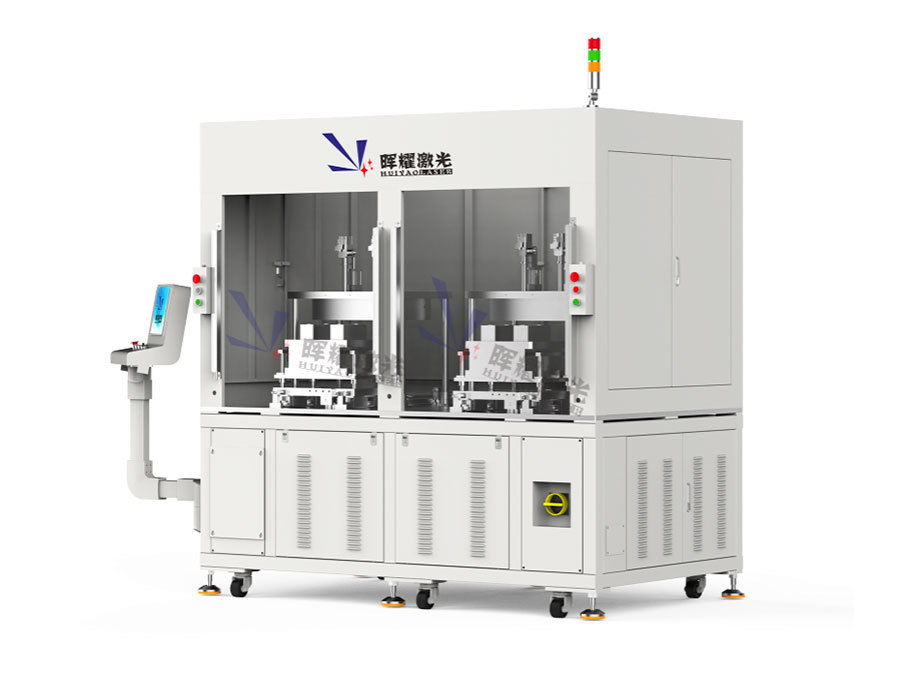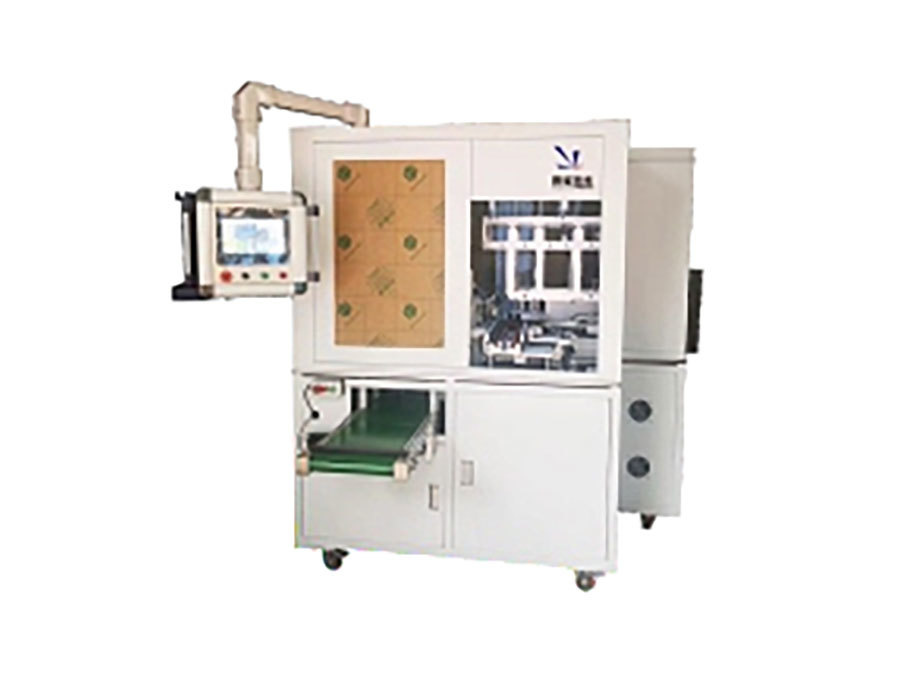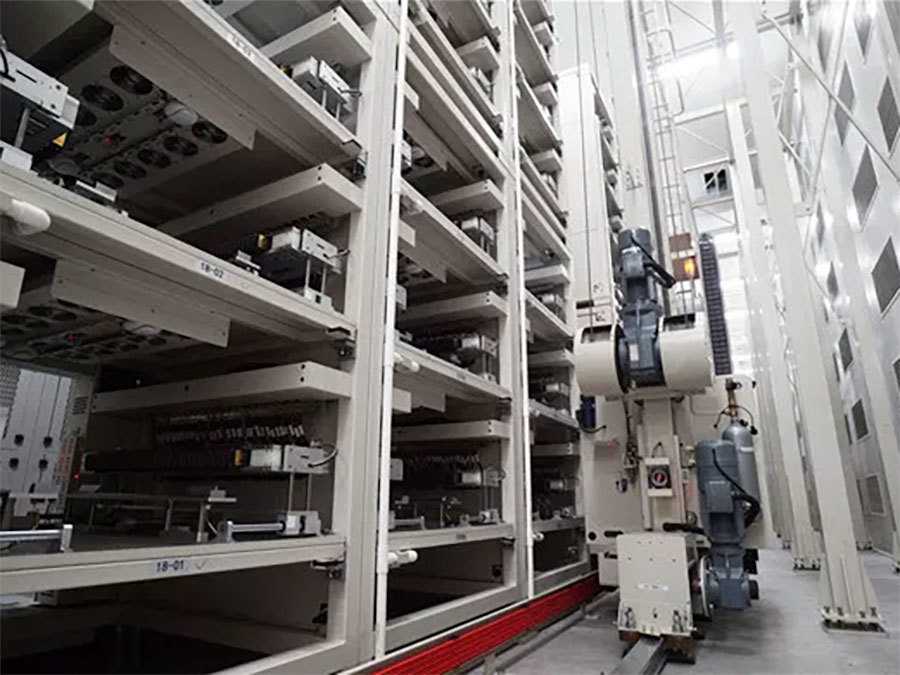Product

Prismatic Battery Cap Manufacture Line
- Product description
-
- Commodity name: Prismatic Battery Cap Manufacture Line
- Commodity ID: 方形铝壳电芯盖板智能生产线
Fully automated production line for prismatic battery cells, integrating critical processes such as explosion-proof valve welding, cover plate assembly welding, air-tightness testing, and impedance/performance testing.
1. Equipment Overview
- Equipment Name: Prismatic Battery Manufacturing Line
- Model: HY-PBML5000
- Application: Fully automated production line for prismatic battery cells, integrating critical processes such as explosion-proof valve welding, cover plate assembly welding, air-tightness testing, and impedance/performance testing.
- Production Capacity: 20–30 cells per minute (process-dependent).
2. Mechanical Specifications
- Equipment Dimensions:
- Length: 15,000 mm
- Width: 3,000 mm
- Height: 2,200 mm
- Weight: 8,500 kg ± 5%
- Modular Structure: Individual stations interconnected with a conveyor system.
- Frame Material: High-strength steel with powder-coated surface for corrosion resistance.
- Worktable Material: Stainless steel with anti-static properties.
3. Key Stations and Specifications
3.1 Explosion-Proof Valve Welding Station
- Welding Method: Precision laser welding.
- Laser Specifications:
- Wavelength: 1064 nm.
- Power: 200 W (adjustable).
- Welding Speed: 1–3 seconds per valve.
- Welding Accuracy: ±0.02 mm.
- Material Compatibility: Aluminum, stainless steel.
- Vision System:
- High-resolution CCD camera for precise valve alignment.
- Real-time monitoring of weld quality.
3.2 Cover Plate Assembly Welding Station
- Welding Method: Resistance or ultrasonic welding.
- Welding Current: 50–500 A (programmable).
- Welding Speed: 8–12 welds per minute.
- Alignment Accuracy: ±0.03 mm.
- Cover Plate Size Compatibility:
- Length: 50–200 mm
- Width: 30–100 mm
- Material Compatibility: Aluminum, nickel-coated steel.
- Pre-Welding Verification: Sensor-based detection of proper plate placement.
3.3 Air Tightness Testing Station
- Testing Method: Helium leak detection.
- Detection Range:
- Minimum Leak Rate: 1 × 10⁻⁶ mbar·L/s.
- Maximum Leak Rate: 1 × 10⁻² mbar·L/s.
- Cycle Time: ≤20 seconds per cell.
- Vacuum Chamber Dimensions:
- Length: 50–300 mm
- Width: 50–200 mm
- Height: 5–100 mm
- Helium Recovery Efficiency: ≥98%.
- Pass/Fail Criteria: Configurable based on customer specifications.
3.4 Impedance and Performance Testing Station
- Testing Parameters:
- Internal Resistance (Impedance): 0.01–100 mΩ (accuracy: ±0.001 mΩ).
- Voltage Range: 0–100 V (accuracy: ±0.01 V).
- Current Range: 0–200 A (accuracy: ±0.1 A).
- Testing Speed: Up to 30 cells per minute.
- Performance Metrics: Conducts charge/discharge cycle simulation and resistance measurements.
- Data Storage:
- Internal Storage: 2 TB SSD for test results.
- Export Formats: CSV, PDF via USB, Ethernet, or cloud.
4. Conveyor System Specifications
- Transport Speed: Adjustable, up to 12 m/min.
- Conveyor Material: ESD-safe belt with wear-resistant coating.
- Load Capacity: 10–15 kg per cell.
- Positioning Accuracy: ±0.05 mm with servo-driven indexing.
5. Control and Interface
- Control System: PLC-based centralized system with integrated monitoring.
- HMI:
- 15-inch capacitive touchscreen with multi-language support.
- Intuitive GUI for station control and monitoring.
- Data Management:
- Recipe storage for different battery models.
- Real-time analytics for production and quality metrics.
- Communication Protocols: Modbus, Ethernet/IP, and OPC UA for factory integration.
6. Electrical Specifications
- Power Supply: AC 380V ± 10%, 50/60 Hz, 3-phase.
- Maximum Power Consumption: 20 kW (entire line).
- Control Voltage: 24V DC for auxiliary systems.
7. Safety Features
- Emergency Stop: Multiple emergency stop buttons at each station.
- Overload Protection: Integrated sensors for load monitoring in conveyors and welding stations.
- Laser Safety: Class 1 laser enclosures with interlocks and safety curtains.
- Helium Leak Detection Alarms: Audible and visual alerts for excessive leak rates.
- Protective Barriers: Transparent enclosures with interlocks for operator safety.
8. Environmental and Installation Requirements
- Operating Environment:
- Temperature: 15–30°C
- Humidity: ≤60% RH (non-condensing).
- Noise Level: ≤75 dB during operation.
- Installation Requirements:
- Flat, vibration-free surface.
- Minimum clearance: 1,000 mm around the equipment.
9. Optional Configurations
- Dual Welding Heads: For higher throughput at welding stations.
- Advanced Vision System: AI-based defect detection for welding and assembly processes.
- Automated Loading/Unloading: Robotic integration for material handling.
- IoT Connectivity: Cloud-based monitoring and remote diagnostics.
10. Maintenance and Warranty
- Maintenance Schedule:
- Weekly: Inspect welding heads, check conveyor alignment, and clean vacuum chambers.
- Monthly: Calibrate test stations and verify alignment systems.
- Quarterly: Comprehensive diagnostics of electrical and mechanical systems.
- Warranty Period:
- Standard: 12 months.
Extended: Up to 36 months available upon request.
Key words:
Prismatic Battery Cap Manufacture Line
Series of Products
Battery Top Cap Welding Equipment
Precise welding of top caps onto battery cases, ensuring airtight sealing and electrical connectivity for prismatic and pouch batteries.
Battery Blue Film Wrapping Equipment
Blue protective insulation film is automatically wrapped around the battery cell to enhance electrical insulation and surface protection.
Automated Guided Vehicles (AGVs) are a crucial component in modern battery PACK factories for transferring materials, components, and finished goods efficiently and safely.
Automated Storage and Retrieval Systems (AS/RS) are an essential part of modern battery PACK factories.
Get a Free Quote
PLEASE LEAVE YOUR MESSAGE AND WE WILL CONTACT YOU AS SOON AS WE RECEIVE IT!
FAQ
Q
How do you ensure consistent weld quality in the assembly of Prismatic battery packs?
A
Q
What are the best practices for cell alignment and stacking in a Prismatic battery PACK assembly?
A
E-mail:
Telephone:
Copyright © Huiyao Laser Technology (Luoyang) Co., Ltd. Has supported ipv6





